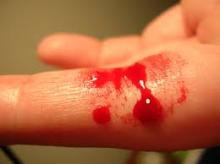Emicizumab beats factor VIII prophylaxis by a wide margin
FROM THE NEW ENGLAND JOURNAL OF MEDICINE
In patients with hemophilia A who do not have factor VIII inhibitors, emicizumab therapy outperformed factor VIII prophylaxis, according to a results of a randomized, open-label, phase 3 trial.
Patients treated with emicizumab had a significantly lower bleeding rate than without prophylaxis, and more than half of the treated patients had no treated bleeding events during the trial, reported lead author Johnny Mahlangu, MD, of the University of the Witwatersrand in Johannesburg, South Africa, and his colleagues.
For patients with severe hemophilia A, factor VIII infusions are standard prophylaxis for bleeding events; however, because of the short half-life of factor VIII, multiple infusions are needed each week, and bleeding events may still occur.
“Treatments with a high efficacy and reduced burden are needed,” the authors wrote in the New England Journal of Medicine.
Emicizumab may serve as such a treatment. It is a monoclonal antibody that joins activated factor IX with factor X. This combination restores hemostasis by replacing missing factor VIII. In 2017, the FDA approved emicizumab for patients with hemophilia A and anti-factor VIII alloantibodies (inhibitors).
The HAVEN 3 trial involved 152 patients with hemophilia A who did not have inhibitors. Patients were divided into four groups. The first three groups (A, B, and C) consisted of patients who had previously been receiving episodic factor VIII therapy. During the trial, group A received emicizumab 1.5 mg/kg per week, group B received emicizumab 3.0 mg/kg every 2 weeks, and group C received no prophylaxis. The fourth group (D) consisted of patients who had previously received factor VIII prophylaxis. This group received emicizumab 1.5 mg/kg per week.
Patients who received no prophylaxis had an annualized bleeding rate of 38.2 events. For patients treated with emicizumab, the annualized bleeding rates were 1.5 events for group A (96% lower than no prophylaxis; P less than .001) and 1.3 events for group B (97% lower than no prophylaxis; P less than .001).
More than half of the patients treated with emicizumab had no treated bleeding events during the trial; in comparison, all of the patients who did not receive prophylaxis had bleeding events. An intraindividual comparison of 48 patients (group D) showed that individuals treated with emicizumab had a 68% lower annualized bleeding rate than when they were receiving factor VIII prophylaxis (decrease from 4.8 events to 1.5 events; P less than .001).
The most common adverse event associated with emicizumab was injection-site reaction in 38 patients (25%). No thrombotic events, thrombotic microangiopathies, or deaths occurred.
“Although it is difficult to predict how the treatment approach will evolve, emicizumab therapy represents one option that holds promise to improve the care of patients with hemophilia A,” the researchers wrote.
The HAVEN 3 trial was funded by F. Hoffmann-La Roche and Chugai Pharmaceutical. The researchers reported support from Bayer, Baxalta, CSL Behring, and others.
SOURCE: Mahlangu et al. N Engl J Med. 2018;379:811-22.





